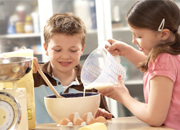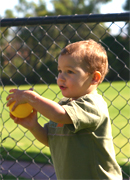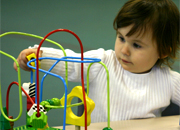Behaviour
Caring for babies
Bottle feeding
Changing a nappy
Cleaning and sterilising bottles
Daily cleaning tasks
Helping new children settle in
Preparing for a nappy change
Sleep patterns – babies
Sleep routines – babies
Toilet training
Caring for children
Allowing time for practice
Dressing/undressing
Mealtimes
Nappy change
Packing away/caring for the environment
Sleep/rest time
Toileting
Common self-help milestones
Tips for sleep and rest time
Self image
Communication
Body language
Limits and guidelines
Ways children communicate
Greeting children and families
Modelling appropriate communication
Questioning
Verbal and non–verbal communication
Acknowledging children's feelings
Listening attentively
Communicating with Aboriginal and Torres Strait Islander parents/carers
Development
Allowing time for practice
Dressing/undressing
Mealtimes
Nappy change
Packing away/caring for the environment
Sleep/rest time
Toileting
Common self-help milestones
Creative development
Language development
Modelling positive relationships
Physical development
Sharing and taking turns
Sleep patterns – babies
Sleep routines – babies
Encourage independent problem solving
Fundamental movement skills
Health, hygiene and safety
Coping with stress
Correct manual handling principles
Daily cleaning tasks
Hand washing
Hand washing poster
Manual handling overview
Toilet training
Safety checklist
Learning experiences and play
Environmentally friendly learning experiences
Learning experiences for different development areas
Creative resource materials
Arranging the environment to facilitate learning and pleasure
Indoors and outdoor areas
Creating a positive physical environment
Legal and ethical issues
Child abuse case studies
How do I recognise when a child or young person is at risk?
Tips on dealing with disclosures
Observation methods
Arranging Experiences (PDF 351Kb)
Recording observations
Rules for making observations
What you can learn from observations
Programming
Children’s interests, strengths, needs and skills
Extending the children’s interest in dinosaurs
Objective observation
Planning an OSHC environment
Behavior management plan
Planning enjoyable experiences
Planning experiences for 0 - 2 years age group
Planning experiences for 2 - 3 years age group
Planning experiences for 3 - 5 years age group
Children’s interests, strengths, needs and skills
What you like to do depends on your interests, strengths and needs. You will notice that the things you like to do are usually those you are good at or have developed the skills to do or simply enjoy. Children are just the same! They are all individuals with their own likes and dislikes.
When planning experiences for the children in your care, you need to take into account the same things. Click on each of the tabs below to find out more.
Below are a number of interests people might have. Soccer, basketball, shopping, bird watching, parachuting, bungee jumping, reading, footy, gardening, and knitting.
Think about the following questions.
- Which of these interests do you like?
- Now take a moment to reflect on how you would feel if someone made you do the ones you didn't select. You probably wouldn't be too happy being involved in an experience that didn't interest you.

Just like you, the interests of a child will determine which experiences they would prefer to participate in. Some children have many interests and are willing to try new things, while other children like to stick to a small range of interests they know and feel comfortable with.
Remember:
- for the emotional security of the child, offer familiar experiences first and then slowly introduce the unfamiliar
- to promote feelings of success, offer simple experiences the child is able to succeed with and then offer more complex experiences to challenge them.
It's important to consider children's interests and try to include these in the experiences you organise for them. The more you can provide experiences that interest them, the more likely they are to want to join in and the more they will enjoy the activity.
Imagine you had a child in your care who was interested in ballet dancing. How could you include this interest in a range of planned experiences? Write your thoughts in your notebook.

Strengths are areas of development children have mastered or are well on the way to mastering. They may include routine tasks or tasks planned to cover the range of developmental areas:
- physical
- social
- emotional and psychological
- language
- cognitive
- creative.
By observing children's play, skills and behaviour as they participate in a range of routines and play experiences, you can identify an individual child's strengths as a basis for planning an environment that is appropriate and enjoyable for your child.
For example, a 2-year-old may enjoy throwing a ball. (As a gross motor skill, this is part of physical development). You will plan and provide opportunities for that child to throw a variety of materials, such as bean bags and balls (large and small), into laundry baskets, boxes and large circles drawn on the ground.

Children grow and develop at individual rates and acquire skills at different ages.
Their needs come from areas of skills they are still developing, acquiring, mastering or refining.
For example, you may identify that a child is still working towards mastering a particular fine motor skill, such as cutting with scissors, when others of the same age in the group are able to do this independently.
For this child to achieve success there needs to be provision in the program for cutting materials such paper or thin cardboard held by someone else.
You might also provide a play dough experience that will help build fine motor strength.

Children can spend up to 12,500 hours in the first five years of life in group childcare. They might then spend another 1,500 hours in before-school or after-school care, or in vacation care. By spending this time away from home, many children miss the opportunity to experience and master such skills as:
- washing and drying dishes
- hanging washing on the clothesline
- folding washing
- making their beds
- sweeping floors
- washing floors
- cleaning tables
- polishing tables and wooden furniture
- podding peas
- peeling potatoes
- digging and planting a flowerbed or vegetable garden
- raking leaves
- sweeping sand
- composting food scraps.
Look at the many ways in which children can be involved in some of these tasks, so that they learn and practise appropriate skills and feel good about contributing to the program. You might even find your workload is reduced and that children show more ownership, respect and care for the equipment and materials if they are responsible for them.